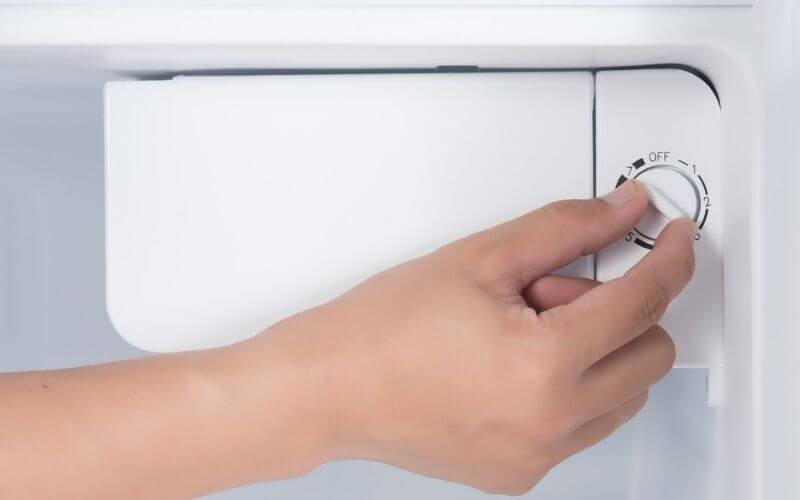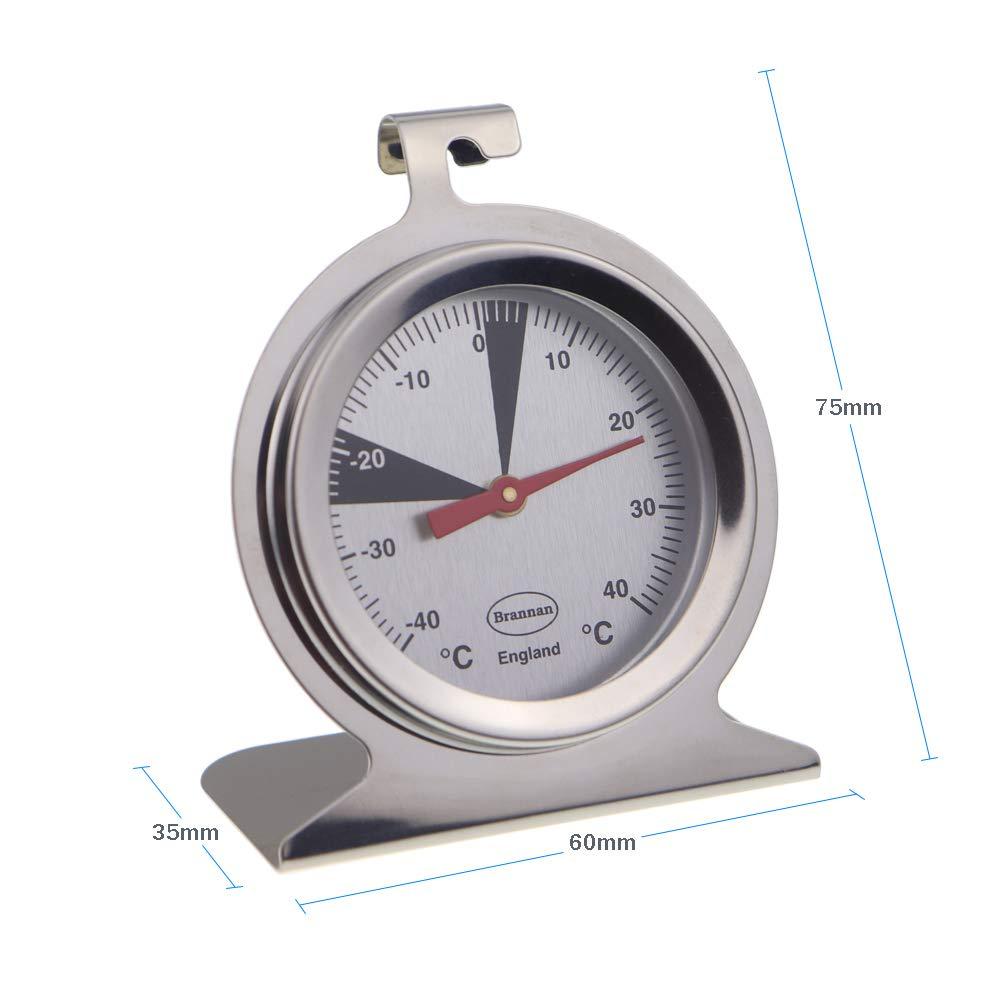The refrigerator temperature dial is a control mechanism located within the refrigerator that allows users to adjust and regulate the internal temperature. It plays a crucial role in maintaining the freshness and longevity of food items stored inside the fridge. By manipulating the temperature dial, users can increase or decrease the cooling intensity of the refrigerator, thereby affecting the temperature inside.
The temperature dial operates in conjunction with the refrigerator’s cooling system, primarily the compressor. When the dial is turned towards the colder setting, it signals the compressor to work harder, resulting in increased cooling and a lower temperature inside the refrigerator. Conversely, turning the dial towards the warmer setting reduces the compressor’s activity, leading to less cooling and a higher internal temperature.
A refrigerator dial is a device found in most refrigerators for regulating temperature. It can be turned to the desired setting, usually between 34 and 38 degrees Celsius (90 and 100 degrees Fahrenheit), to set the refrigerator’s internal temperature. Sometimes a dial may also have a probe that draws in ambient air from outside the refrigerator and operates an evaporator fan that cools down incoming air before it is introduced into the inside of the appliance.
The dial will often include instructions on how to use it or provide information about its function. Refrigerator dials are usually in the back of the refrigerator as they are not used often. They may be hidden behind a plastic shroud or under a metal basket, and some older models may have a dial on the front. This is to protect it from being accidentally turned or bumped.
Check also: Fridge Not Cooling, But Light is On – Reasons and Solutions to Fix Fridge
The refrigerator’s temperature can be lowered for when food is to be stored in it or raised for warm weather conditions when the door is opened more often, and food needs to either cool off more quickly or warm up faster. Some refrigerators include a mechanism that automatically lowers the temperature during hot weather, thereby reducing energy usage and preventing damage to food due to overheating.
Table of Contents
Things you should know – Refrigerator Temperature Dial
A typical refrigerator will have 2 of these, one for the freezer and one for the fridge. A thermostat or an auto-defrost system will be used to maintain a constant temperature while the door is closed. When the door is opened, the fridge temperature will rise faster than the freezer.
If this happens frequently, it can cause spoilage. Many models include a sensor that detects if the door is open and performs an auto defrost when necessary. Refrigerators should have a thermostat that will allow them to automatically maintain a temperature of 37 degrees Celsius (too hot) or 2 degrees Celsius below that temperature (too cold). The more accurately you set the temperature control, the more energy efficient it will be. Setting it too low or too high can lead to increased energy usage and may not be good for certain foods.
It is also a good idea to clean your temperature control dials every so often so they can function properly without harming your food or causing unnecessary stress on your refrigerator. Use a soft cloth dampened with warm water and mild soap to wipe down the dials. Be careful not to get water or cleaner inside the dials, as that could cause them to malfunction.
Conclusion
The refrigerator temperature control dial is a very important part of the refrigerator. It allows you to choose how low or high the temperature will be inside your fridge at any time. Adjusting the dial accordingly, you can use it to keep your food either colder or warmer than usual. It can also ensure that your food does not spoil if you do not use it often and that it does not freeze if you open the fridge every few minutes.
FAQs
Q: What is the purpose of the refrigerator temperature dial?
A: The refrigerator temperature dial allows you to adjust the internal temperature of your refrigerator. It helps maintain the ideal conditions for preserving food freshness and preventing spoilage.
Q: How does the refrigerator temperature dial work?
The temperature dial controls the refrigerator’s cooling system. When you adjust the dial, it regulates the compressor’s operation, which affects the cooling intensity inside the fridge. Turning the dial towards the colder setting increases the cooling while turning it towards the warmer setting reduces the cooling.
Q: What are the recommended temperature settings for a refrigerator?
A: The recommended temperature for a refrigerator is typically between 35°F (1.7°C) and 38°F (3.3°C). This temperature range helps inhibit bacterial growth and keeps perishable foods fresh for a longer duration. However, it’s important to refer to the manufacturer’s instructions as different refrigerator models may have slight variations.
Q: How can I find the right temperature setting for my refrigerator?
A: To find the right temperature setting, start with the manufacturer’s recommended range mentioned in the user manual. Place a thermometer in the center of the refrigerator and wait for it to stabilize. Adjust the temperature dial accordingly, and monitor the thermometer to ensure the desired temperature is maintained.
Q: Should I adjust the refrigerator temperature dial based on the seasons?
A: In most cases, you don’t need to adjust the temperature dial based on the season. Refrigerators are designed to maintain a consistent temperature throughout the year. However, if you notice temperature fluctuations or if your refrigerator is located in an area with extreme temperature changes, you may need to make slight adjustments to compensate for external factors.
Q: What should I do if my refrigerator is too cold or not cold enough?
A: If your refrigerator is too cold, try adjusting the temperature dial towards a slightly warmer setting and monitor the temperature over a few hours. If it’s not cold enough, turn the dial towards a colder setting and allow time for the temperature to stabilize. If the issue persists, check for any obstructions in the vents, ensure proper airflow, and consider contacting a professional if needed.
Q: Can opening the refrigerator frequently affect the temperature?
A: Opening the refrigerator frequently can cause a temporary rise in temperature due to the influx of warmer air. However, modern refrigerators are designed to quickly recover and return to the set temperature. To minimize temperature fluctuations, try to limit the duration and frequency of door openings.
Q: How often should I check and adjust the refrigerator temperature dial?
A: It’s recommended to check the refrigerator temperature periodically, especially if you notice any issues with food spoilage or inconsistent cooling. Adjustments to the temperature dial should be made gradually and monitored for a few hours to ensure the desired temperature is achieved and maintained.
Q: Can I use a separate thermometer to monitor the refrigerator temperature?
A: Yes, using a separate thermometer to monitor the refrigerator temperature is a good practice. Place the thermometer in a central location inside the fridge and check it periodically to ensure the temperature remains within the recommended range.
Q: Should I set the same temperature for the freezer and refrigerator compartments?
A: No, the freezer and refrigerator compartments have different temperature requirements. The freezer should be set to a temperature around 0°F (-18°C) to ensure proper freezing and storage of frozen foods. The refrigerator compartment should be set to a slightly higher temperature within the recommended range for optimal food preservation. Refer to the user manual or manufacturer’s guidelines for specific temperature recommendations for your refrigerator model.

Virat Raj is a Digital Marketing Practitioner & International Keynote Speaker currently living a digital nomad lifestyle. During his more than 10 years-long expertise in digital marketing, Virat Raj has been a marketing consultant, trainer, speaker, and author of “Learn Everyday yourself: In Pursuit of Learning” which has sold over 10,000 copies, worldwide.


